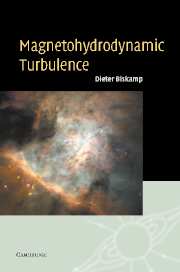Book contents
- Frontmatter
- Contents
- Preface
- 1 Introduction
- 2 Magnetohydrodynamics
- 3 Transition to turbulence
- 4 Macroscopic turbulence theory
- 5 Spectral properties and phenomenology
- 6 Two-point-closure theory
- 7 Intermittency
- 8 Two-dimensional turbulence
- 9 Compressible turbulence and turbulent convection
- 10 Turbulence in the solar wind
- 11 Turbulence in accretion disks
- 12 Interstellar turbulence
- Outlook
- References
- Index
5 - Spectral properties and phenomenology
Published online by Cambridge University Press: 17 August 2009
- Frontmatter
- Contents
- Preface
- 1 Introduction
- 2 Magnetohydrodynamics
- 3 Transition to turbulence
- 4 Macroscopic turbulence theory
- 5 Spectral properties and phenomenology
- 6 Two-point-closure theory
- 7 Intermittency
- 8 Two-dimensional turbulence
- 9 Compressible turbulence and turbulent convection
- 10 Turbulence in the solar wind
- 11 Turbulence in accretion disks
- 12 Interstellar turbulence
- Outlook
- References
- Index
Summary
Until now we have viewed the turbulent motions and fields mainly in space, or configuration space. Though spatial structures are important in MHD turbulence, for instance as final states of selective decay processes, the most characteristic property of fully developed turbulence is the presence of a wide spectrum of different scales. Turbulence scales have already been used in a very loose way in Section 4.2.2 in discussing the mechanism of dynamic alignment. In this chapter these ideas will be given a more precise meaning. In Section 5.1 we introduce the concept of homogeneous turbulence, a very useful idealization of a turbulence field far away from boundary layers. Here the Fourier components of the field play the role of the amplitudes at a certain scale l ∼ k−1. Section 5.2 considers an approximation that, at first sight, has little resemblance to real turbulence, namely a nondissipative system of Fourier modes truncated at a finite wavenumber and its relaxed states, which are called absolute equilibrium distributions. In spite of their artificial character such states can provide valuable information about the tendencies of the spectral evolution in dissipative systems, in particular the direction of the spectral fluxes called cascades. In Section 5.3 we then switch on dissipation in order to study the spectral properties of MHD turbulence.
- Type
- Chapter
- Information
- Magnetohydrodynamic Turbulence , pp. 86 - 112Publisher: Cambridge University PressPrint publication year: 2003



